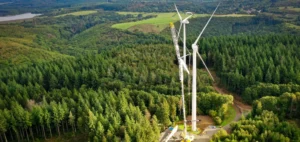The Swedish government announced on Tuesday that it had authorized the construction of two offshore wind farms, bringing together a hundred turbines off the country’s west coast, stressing that this did not mean abandoning nuclear power.
When finished, in seven to 10 years, the two parks should produce 6.5 terawatt hours (TWh), estimated Stockholm. Two permits have been awarded: one to the Swedish state-owned company Vattenfall for the “Kattegatt Syd” park, with 80 turbines, and the other to the renewable energy company OX2 for the “Galene” park, with 21 turbines. “These two offshore parks are roughly equivalent to a normal-sized nuclear power plant,” Prime Minister Ulf Kristersson said at a press conference.
The head of government also emphasized that nuclear power was also part of the government’s strategy to increase Sweden’s production of “fossil-free energy,” noting that Parliament was about to change its target from 100% “renewable” energy to 100% “fossil-free” energy. “For the first time in 43 years, nuclear power will be part of Swedish energy policy in the long term,” Kristersson said.
In 1980, the Scandinavian kingdom voted in a non-binding referendum to phase out nuclear power. Since then, Sweden has closed six of its twelve reactors and the remaining reactors, installed in three nuclear power plants, produce about 30% of the electricity used in the country today. But Sweden, which gets nearly half of its electricity from hydroelectric sources, is struggling to find viable alternative energy sources to replace nuclear power, as renewable energy is not yet able to fully meet its needs.






















